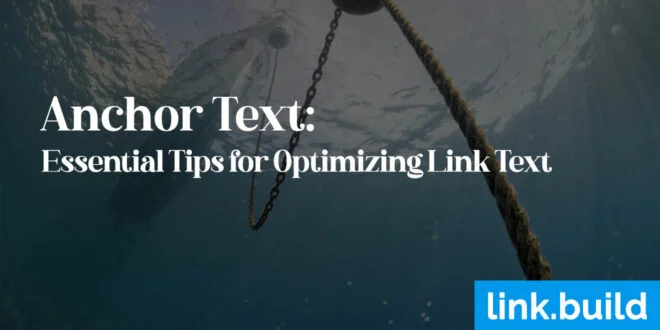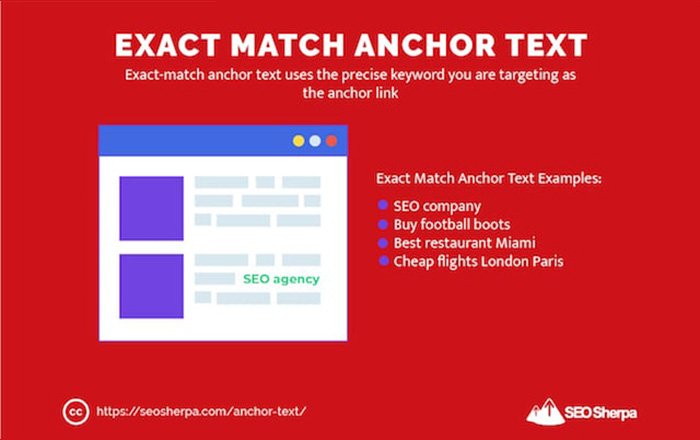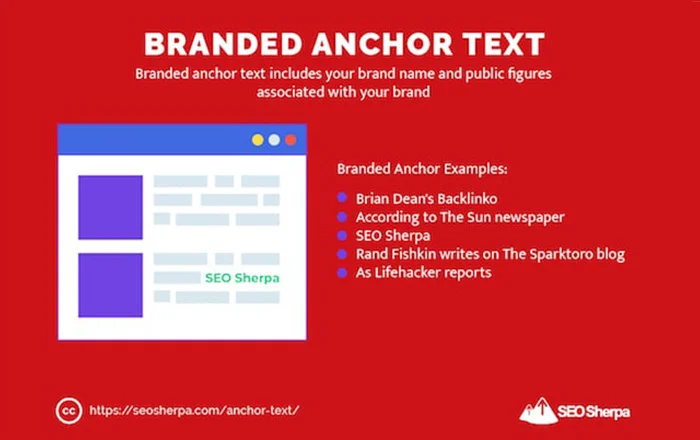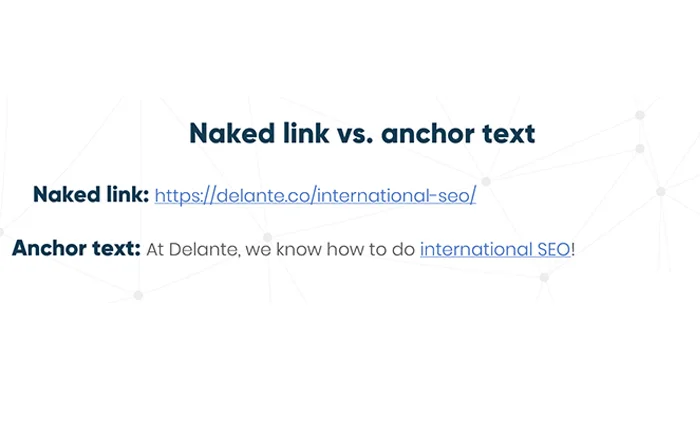Anchor Text: Essential Tips for Optimizing Link Text

Anchor text refers to the visible, clickable words or phrases of a hyperlink used to transfer users to a different page on the same website or an outside source. Understanding proper anchor text optimization and use is essential for search engine optimization (SEO).
By making use of varying types of relevant anchor texts, webpages can rank higher in organic search results and improve overall SEO performance. In this outline, best practices for optimizing anchor text along with common link-building mistakes to avoid will be brought into light in order to optimize a webpage's visibility but also ensure user experience.
Types of anchor text
Exact match anchor text

Exact match anchor text is a type of anchor used in SEO. This anchor type sources out the key phrase or keyword that accurately reflects and matches what will be found on the other side upon clicking it; this eliminates ambiguity when redirecting users from one page to another.
Their only purpose is for link building, therefore they are beneficial for improving linkage viewership, as their single-goal nature makes them easy to pinpoint, click, and visit compared to other faux anchoring available.
While exact match anchors aren't ideal due to search engine algorithms monitoring use prevalence (and given that overuse leads to practices such as keyword stuffing), minimal usage with smart strategy offers great benefits when combined with an overall strong SEO approach.
Partial match anchor text

It is one type of anchor text used in SEO. It consists of a keyword phrase or words within the link but does not exactly match the target website's page title or URL.
This type targets specific phrases and can help search engines understand what content is being linked to without exceeding optimization limits, which can result in penalties from Google.
When using partial match anchor terms, additional synonymous keywords may be included for increased fidelity within the context of the link placement as long as it still remains readable to the user and provides clarity on what content they should expect once they click on it.
Branded anchor text

Branded Anchor Text includes the linking of target domain names or even brand names that indicate live on a given website.
It increases authority because it illustrates direct linkages to other authentic referrals, particularly when established domains from leading global websites are included; these types of anchor text effectively contribute towards establishing reliability and designing backlink profiles that look more attractive from the perspective of both search engines, as well as visitors, enabling them to better trust your brand click-worthy links.
Naked URL anchor text

Naked URL anchor text (often simply called URL anchors) is arguably the most straightforward type of anchor text to utilize.
They often appear as simple hyperlinks with no additional words or phrases attached - essentially, just buffering a website address in other content. Naked URLs may be used if linking to an external URL from one's own website domain is deemed necessary; utilizing such naked links provides accuracy and clarity since the destination page's full address is accessible at all times for visitors and search engine crawlers alike.
Note that any embedded link can act as a form of naked ULR, regardless of associated copy or context - thereby emphasizing their importance despite being inconsistently recognized beyond basic hyperlinking protocols.
Generic anchor text

Generic anchor text is a type of anchor text used when no keyword targets are desired. Usually, the words "click here" or words similar to it are used as the link description. An option like "learn more" is also often seen in menus on websites when looking for more detailed information relative to a smaller subsection of linked pages.
Generic anchor text has its own advantages: it may prevent over-optimization that Search Engines frown upon but can still inspire users and inform them, something regular HTML code phrases don't necessarily do because they experience fewer delays between viewing the link and shifting to action.
Best practices for optimizing anchor text

Relevance to the linked page
To create anchor text effectively, the content must be well-matched to the destination page's topic. Poorly chosen anchor texts won't boost your relevance rankings in search engine results pages and will provide a disorganized user experience that fails to meet expectations.
Be sure the link is explicitly informative and includes pieces of information relevant to both the starting/destination pages, as this connection gives clear context for readers about what they'll find on the other side of the click.
Diversity in anchor text
When optimizing anchor text, it's important to diversify the types of keywords used. Anchor text that uses too many similar or identical keywords can be detrimental to SEO efforts and search engine rankings. Aiming for a natural range in keyword variations also helps lend SEO credibility.
This helps ensure that the linked page appears more often in different kinds of searches related to the site theme as opposed to constantly ranking pages with similar language due solely to target keyword repetition working against other contextual factors. Users are also more likely to click a link when the anchor text seems detailed and authentic.
Avoiding over-optimization
Avoiding anchor text over-optimization is an essential part of crafting effective SEO. Companies should ensure that the ratio of their target keywords to other, more naturally composed varieties remains natural. Google's algorithm works on machine learning, which means it can easily detect any irregularities, such as unnatural amounts of the same anchor text or keyword disproportionately repeating in a given area on a web page.
Therefore, companies should engage caution and intention when linking images back with anchor text since they are the strongest potential triggers for algorithm suspicion. Additionally, care must be taken to link phrases naturally rather than single words, as this practice often looks suspicious of Google's grading.
Natural language and readability
When optimizing anchor text, natural language, and readability should always be top considerations. Since users can see clickable text or links within content for context clues, overly keyword-driven anchors create an unnatural subject line instead of being clear about the page that's being linked to.
For greater engagement and a more user-friendly experience, use customized phrases or tailored propositions and ensure that keywords are used in moderation rather than pouring them into sentence after sentence.
Most importantly, familiarize yourself with natural phrasing so link descriptions fit the surrounding topic while still conveying what types of information readers will find upon clicking on it. By focusing on clarity first above all else, search engine optimization best practices around anchor text can promote both user experience and rankings across multiple SERPs.
Linking to high-quality and authoritative sources
If you want to ensure your SEO efforts with rich anchor text are successful, it's essential that you link up with high-quality and authoritative sources. Relevant websites or pages backed up by experts can illustrate to users—and search engines—that this is a trusted source of information they require.
Linking out to credible websites such as government agency sites, independent industry review hubs, or press outlets signals to search engines that not just the website but also the page linked off contains quality content as verified through reliable channels.
However, keep in mind not to simply swap out links all too frequently; including relevant and fresh internal links whenever possible helps confirm links on other external sites for better long-term result optimization.
Contextual placement of anchor text
Contextual placement of anchor text means ensuring the link is appropriate in context with the surrounding content. Where a link is placed should be natural to visitors and help explain the relevance or connection to the linked page.
Anchoring links within natural sentences and using keywords that support surrounding content allow readers to better comprehend what they're likely to find on clicking through, making them more willing (and likely) to take this action.
When choosing where anchor text should go inside a sentence, strategic internal linking allows for improved user experiences while providing additional value to web pages without compromising SEO advantages.
Common mistakes to avoid
Keyword stuffing
Keyword stuffing is when an author uses a large number of search terms within the content and metadata in order to elevate their ranking on Google. This can range from repeating exact match anchor phrases multiple times, to inserting keywords unnecessarily throughout the text. While keyword optimization can have its benefits for SEO, it's important to vary up your selectors and ensure link placements are naturalized too.
Linking related keywords is one technique; however, excessive duplication could result in the page being negatively exploited by search engines, as keyword stuffing can appear spammy and manipulative. Excessive and unnatural repetition of words has been known to earn ridicule should users stumble across obvious dupes.
Using excessive exact match anchor text
Using excessive exact match anchor text, or anchors that contain an exact keyword phrase in the linking text, is a major mistake to avoid when optimizing anchor text. Exact match anchors should only make up around 15-20 percent of the total links used and can easily come across as spammy to visitors.
Overuse of this type of link will also increase potential Google penalties due to their algorithm and suspicion of over-optimization. When creating perfect-match link types, use them sparingly for best practice optimization outcomes and high readability for users.
Overusing commercial or promotional anchors
One mistake that can lead to anchor text penalties is overusing commercial or promotional anchors. This involves including promotional words that link back to the website too often, such as "click here" or "check out our site."
As these have no direct relevance to the content at hand and contain language related directly back to the site itself, they tend to break the best practices outlined in search engine optimization.
Searchers began seeing these unique links as unnatural, spammy links which Google started demoting altogether — any visible manipulation for SEO gains is considered against their standards. To abide by appropriate optimization, only include anchor text if it's relevant and natural — otherwise, you risk attracting negative attention from search engines.
Conclusion
The importance of anchor text in SEO can't be understated – when used strategically, it helps boost CTRs and direct people to the right pages on your website. However, it is important to keep in mind that user experience requires balance with any efforts you take to optimize anchors.
To ensure the best results, focus your optimization efforts on the relevant keywords, and use diverse types of anchor text throughout your content while avoiding keyword stuffing that might reflect sloppy unpolished content for users to interact with negatively affecting authority levels.
Use an exact match or branded terms sparingly but don't forget about using a generous helping of generic phrases accordingly sprinkled around those exact matches. Always remember that experienced users can sniff poorly placed pushy anchors from miles away; use topical landmarks for contextual placements that will guide your audience like a beacon.


.svg)

.jpg)
.jpg)
.jpg)